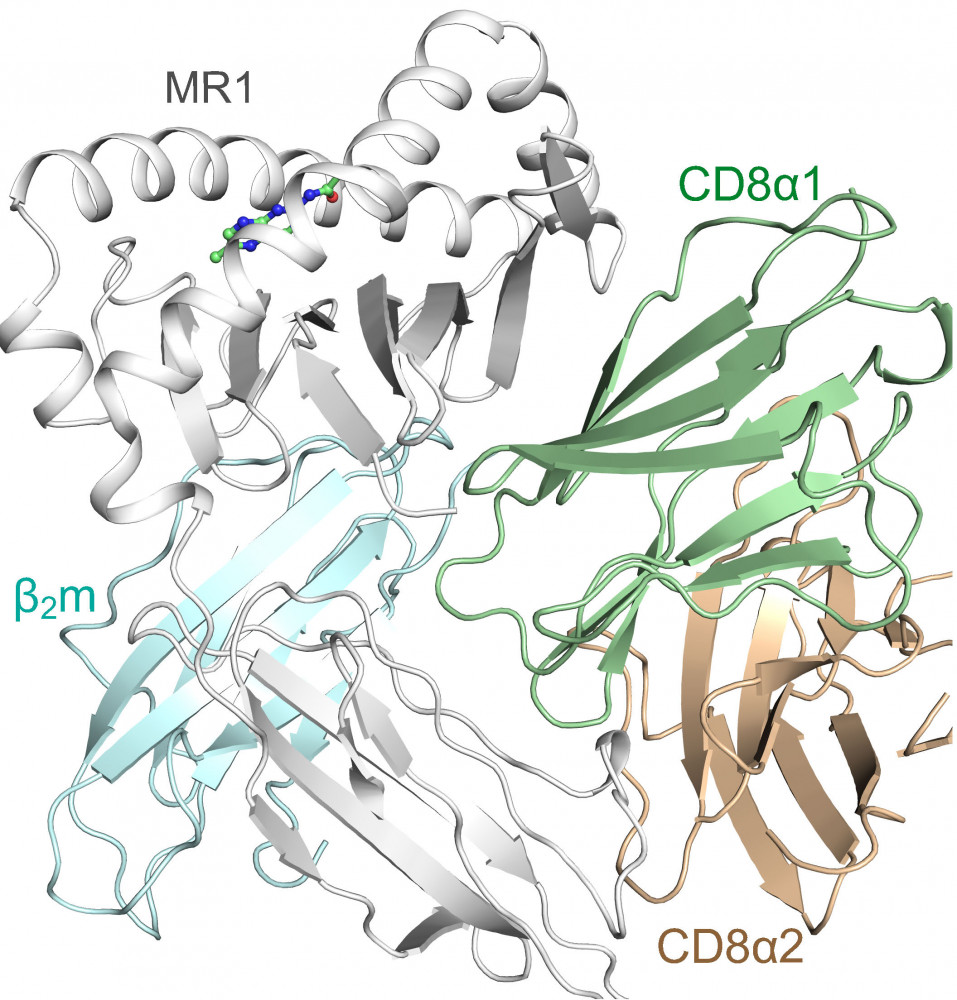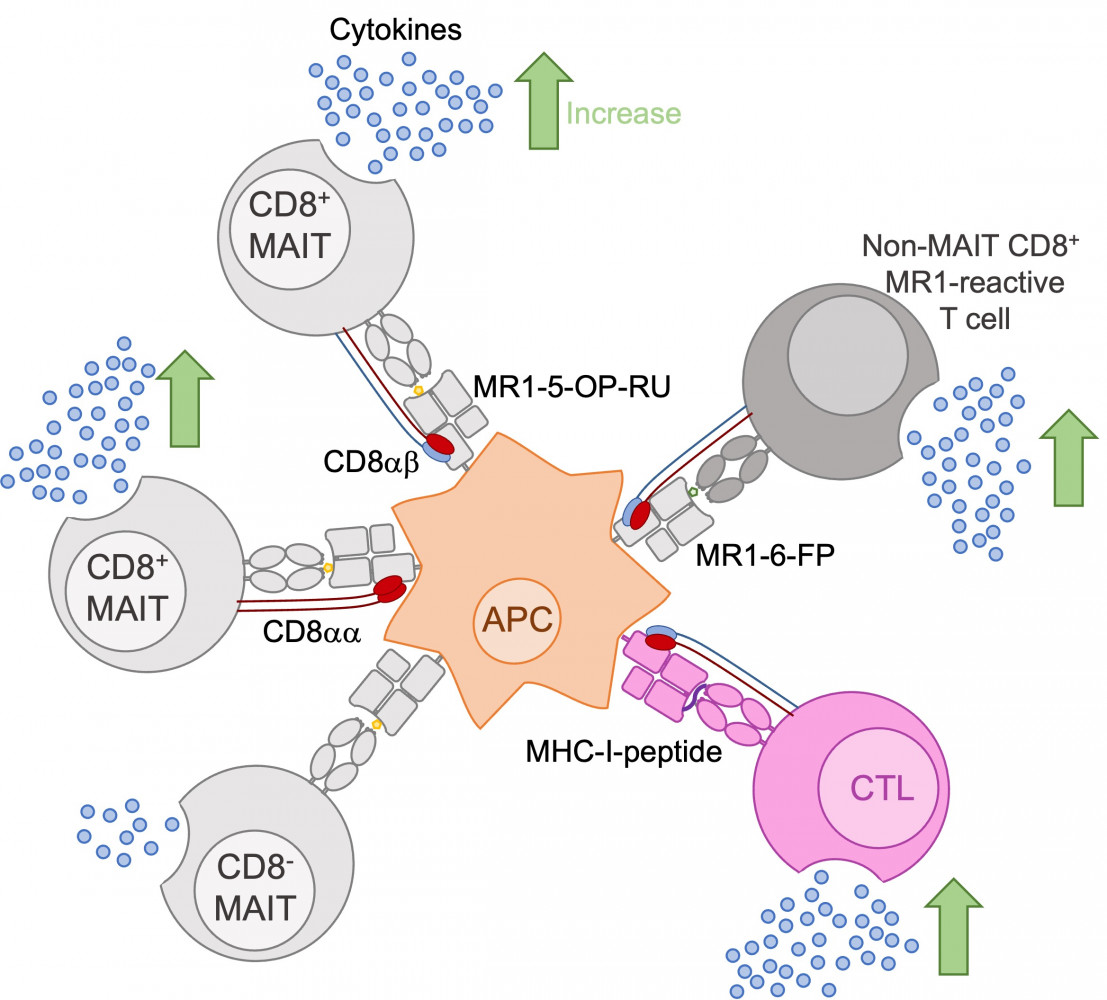26 Aug 2022
New study unlocks fundamental understanding of MAIT cells
Funding: NHMRC, ARC, Allergy and Immunology Foundation of Australasia (AIFA)
DOI: 10.1084/jem.20210828
Researchers at the Peter Doherty Institute for Infection and Immunity (Doherty Institute) made a fundamental discovery about how MAIT cells function, especially in the context of protective immunity.
Mucosal-associated invariant T (MAIT) cells are a subset of innate-like T cells and an integral part of the body’s immune defence against microbial infections. Similar to conventional T cells, the recognition event that triggers a MAIT cell response is the interaction between the T cell receptor (TCR) expressed by MAIT cells and its ligand MHC class I (MHC-I) related protein 1 (MR1) expressed by antigen presenting cells. While a lot is known about this interaction, not much is known about other MAIT cell receptor-ligand interactions.
One of the receptors that most MAIT cells express is the coreceptor CD8. The same receptor is also expressed by conventional killer T cells and for those cells its function is well defined, namely, to simultaneously bind MHC-I with the TCR to enhance T cell responsiveness. The team investigated whether CD8 can interact with MR1 and the consequences of this interaction for MAIT cell immunity.

A schematic representation of the CD8 and MR1 protein interaction determined using X-ray crystallography. The MR1 protein (grey) associates with b2-microglobulin (b2m, cyan) and together this complex is bound by a CD8 protein, consisting of two CD8a subunits (CD8a1 in green, CD8a2 in brown). The finger-like extensions of the CD8 protein latch onto a flexible loop on the lower portion of the MR1 protein. This region is the primary contact site between CD8 and MR1 proteins and mutation of this site abolishes the interaction.
Previous conflicting studies speculated whether CD8 does or does not interact with MR1 based on MR1 sequence homology with MHC-I. This new experimental study, published today in the Journal of Experimental Medicine, revealed that CD8 does indeed bind MR1 and that this interaction actually enhances MAIT cell antigen recognition and associated functional responses. It is also critical for the recognition of MR1 presenting folate-derived antigens by other MR1-reactive T cells, a distinct population of T cells that little is known about.
“Our finding that CD8 binds MR1 fills a knowledge gap in the fundamental biology of MAIT and other MR1-reactive T cells,” says University of Melbourne Dr Michael Souter, Immunologist at the Doherty Institute.
“This interaction is likely an integral part of the protective immune function of MAIT cells in microbial infections and maybe cancer, enhancing MR1 recognition and broadening the repertoire of MR1-bound antigens that can be cross-recognised (an active area of research in the field).”
However, just like conventional T cells, MAIT cells are expected to not always function perfectly.

It is well established that CD8ab binds to MHC-I concomitantly with the T cell receptor (TCR) and this way enhances the TCR-MHC-I interaction and thereby the cytokine production by conventional T cells. We now show that CD8aa and CD8ab expressed by MAIT cells also binds to MR1, leading to increased cytokine production by MAIT cells. In addition, the interaction between CD8ab expressed by non-MAIT MR1-reactive T cells and MR1 is critical for their cytokine production.
“The CD8-MR1 interaction may also drive autoreactivity and cross-reactivity with pathological consequences, which may lead to autoimmune or allergic reactions,” explains University of Melbourne Dr Sidonia Eckle, Immunologist and Group Leader of the MAIT Cell Program at the Doherty Institute.
“It has been recognised that MAIT and other MR1-reactive T cells combine a number of features that render them suitable targets for immunotherapies. However, this is still an emerging area of research and a complete understanding of how exactly they function is needed in order to harness them therapeutically,” says Dr Eckle.
“Our study, delineating the function of CD8 coreceptor expressed by most MAIT and other MR1-reactive T cells, provides an important piece to this puzzle.”
This research is the result of a collaborative effort involving researchers from University of Melbourne’s Department of Microbiology and Immunity at the Doherty Institute, MCRI, Monash University, CSIRO and University of Queensland.


